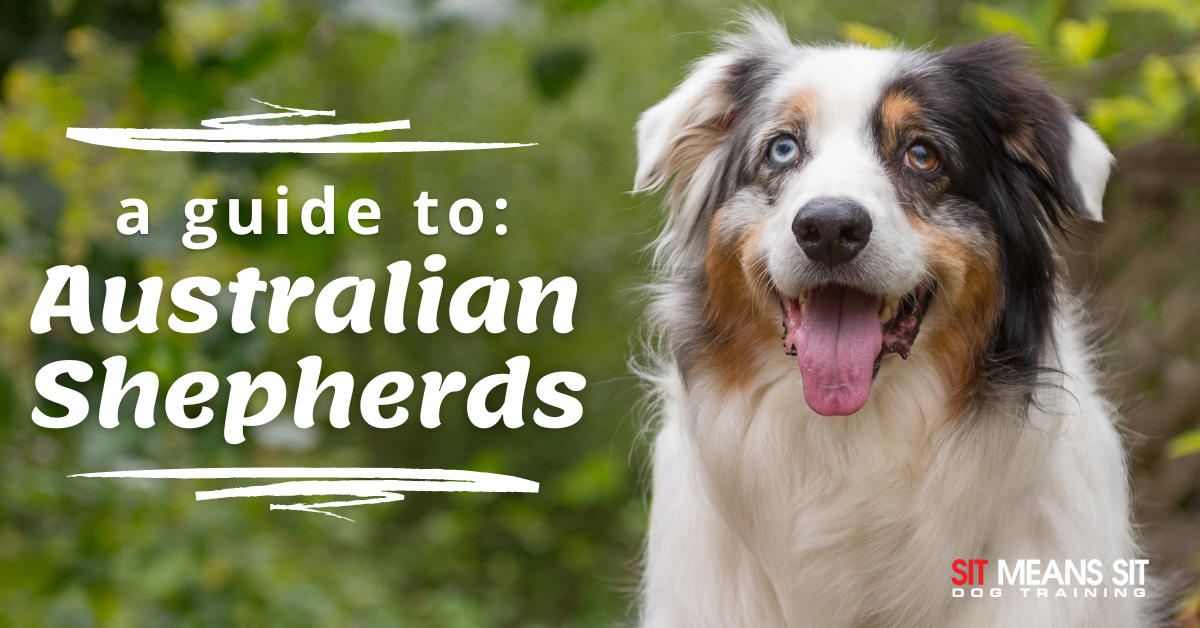
Everything You Need to Know About Australian Shepherds
Bringing home a dog is a big step in a person’s life that requires a lot of careful consideration and planning. From researching temperament, dietary needs, and overall health of a breed, there is a lot a dog owner needs to know. Especially when bringing home a big dog like a Doberman.
Thinking about bringing home an Australian Shepherd? Here’s what you need to know.
History
Australian Shepherds have a pretty deceiving name as they are actually an American breed of dog. They were originally bred to herd livestock for ranchers and farmers in the western U.S. and some Aussies today are still doing exactly that.
While it is unknown which breeds were originally used to create the Australian Shepherd, it’s likely that an Aussie’s ancestry includes collies and other shepherd-type dogs that were imported to the U.S. from Australia in the 1840s – hence the Australian name.
Since then, breeders have worked to create the ultimate herding dog who is versatile, hard-working, and intelligent. The breed had a huge boost in popularity post-World War II as people became more interested in the Western lifestyle and horseback riding. Australian Shepherds were frequently seen at rodeos, and horse shows, as well as in western movies and TV. However, despite its rise in popularity, the Australian Shepherd was not recognized by the American Kennel Club until 1993.
Quick Facts
- Height: 18 to 23 inches tall at the shoulder
- Weight: 40 to 65 pounds
- Life Span: 12 to 15 years
- Breed Category: Herding Dogs
- Shedding: Yes
Temperament and Personality
Since Australian Shepherds were bred to be pushy leaders with livestock, they will assume a dominant role in your home if you don’t give them firm leadership. This can mean that an Australian Shepherd is not a good choice for first-time or timid dog owners.
Aussies are extremely loyal to their families, just like most other herding dogs. However, this loyalty can often mean that they are standoffish with strangers, so early socialization is a must while they are young so they can get used to being around new people, sights, and sounds.
The herding genes run extremely strong in this breed, so if you are bringing an Aussie into a home with other animals or kids, they may consider them to be part of their flock and try to herd them by chasing and nipping at them. You will have to discipline this behavior so they know it is not allowed. Once this lesson has been learned, they will make a wonderful family dog.
Health
Aussies are generally very healthy, but like any other dog, can be prone to certain health conditions. Some of these might include:
- Hip Dysplasia: This occurs when the femur doesn’t fit snugly into the hip joint. Dogs with hip dysplasia are not meant to be bred so ask your breeder for proof that the parents have been screened for hip dysplasia.
- Epilepsy: This is a seizure disorder that can plague Australian Shepherds. It can be treated with medication to help your dog live a happy and healthy life but there is no cure.
- Deafness: This is relatively common in this breed. While it often cannot be cured, there are certain treatments available to make your dog’s life easier.
Care
Aussies are extremely active so they will need plenty of space to run and explore safely. A fenced yard is highly recommended for this dog breed. Make sure it is secure so they can’t jump over it or dig under it. Electric fences are not effective for this breed as their desire to herd will outweigh any potential shocks they may get. This herding urge also means you will have to keep your dog leashed in public and on walks to avoid them running off.
Australian Shepherds are also highly intelligent so they will need at least a half hour of stimulating activity each day. This could be an outdoor walk or run, a game of fetch or frisbee, or puzzle games to keep their mind occupied.
Aussie puppies don’t need as much exercise as adults and it is recommended that you don’t let them run on hard surfaces such as concrete for the first year of their life. It can put unnecessary strain on their still-developing skeletal system and can cause joint problems.
Obedience classes are recommended to train your dog to ignore their frequent herding urges of nipping and chasing. This breed responds well to positive reinforcement in their training and enjoys praise, play, and food as rewards. They will be happy to take commands from their trainer as they want to do a good job for whoever is in charge.
As for grooming care, your Australian Shepherd will moderately shed throughout the year and more heavily during spring as they lose their winter coats. Brush their coat weekly to help aid their shedding and prevent mats. Also, frequent brushing will extend the amount of time your dog can go between baths, so they will only need a bath a few times a year. Trim their nails if you can hear them clicking on the floor and brush their teeth weekly.
Overall, the Australian Shepherd is a wonderful family dog who will remain loyal and happy to be in your home. If you are looking to adopt an Australian Shepherd as opposed to getting one from a breeder, go to the Aussie Rescue and Placement Helpline for more information.
